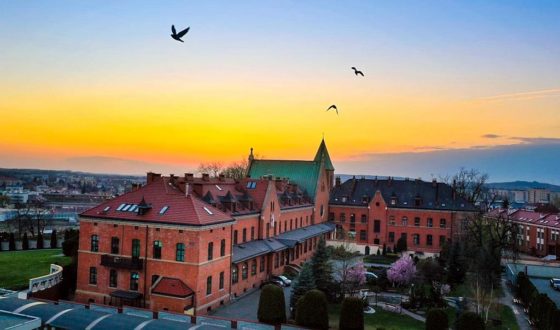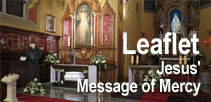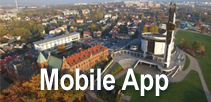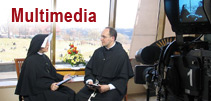The Congregation of the Sisters of Our Lady of Mercy has embarked on a redevelopment project for the Kraków Shrine of Divine Mercy at Łagiewniki. We are planning to build new facilities for pilgrims and Apostles of the Divine Mercy to accommodate the St. Faustina multimedia museum, a scholarship and research centre, a library, archives to hold records of the devotion to the Divine Mercy; and for the Misericordia Publishing House.
Donations for the project may be paid into the following bank accounts:
Zgromadzenie Sióstr Matki Bożej Miłosierdzia
(The Congregation of the Sisters of Our Lady of Mercy)
ul. Siostry Faustyny 3, 30-608 Kraków,
Phone +48 12 351 88 00
BNP Paribas Bank Polska S.A.
Odział w Krakowie, ul Armii Krajowej 28
30-150 Kraków
PLN: 34 1600 1013 0002 0012 3671 2150
EUR: 46 1600 1013 0002 0012 3671 2031
USD: 41 1600 1013 0002 0012 3671 2024
Kod swiftowy banku: PPABPLPK
IBAN: PL
WHAT IS STILL NEEDED AT ŁAGIEWNIKI?
Łagiewniki
The Shrine of Divine Mercy at Łagiewniki is a place familiar to people on every continent, and every year pilgrims come here from over 80 countries worldwide. This place is a venue for people from all over the world regardless of origin or language, as we see in the different ways our pilgrims are dressed in their traditional costumes (like Indian saris, Japanese kimonos and Native American headdresses). At Łagiewniki you’ll hear words like mercy, Barmherzigkeit, milosrdenstvo, misericordia, miloserdye, rahamim practically on an everyday basis ‒ not surprisingly, since Łagiewniki is the centre for the devotion to the Divine Mercy, the heart and source of the message Jesus gave Sister Faustina. Łagiewniki is a spiritual centre for those who worship God and know He is rich in mercy. It is the place where the relics of one of the greatest saints in the history of the Church have been laid to rest. It is a place where even popes come on pilgrimage, not to mention cardinals, bishops, chaplains and priests together with their congregations; they all come to this source of mercy to ask for graces and to build up their hope.
What does Łagiewniki offer already?
Pilgrims visiting Łagiewniki come before God and here they find what they need, since this is a special place, as Pope John Paul II observed, a place chosen by God, where people experience His living presence and grace. That’s why pilgrims want to make their way to the Convent Chapel of the miraculous image of the Merciful Jesus and kiss the relics of St. Faustina. They want to participate in the liturgy of the Holy Mass, to benefit from the Sacrament of Reconciliation, and pray before the Blessed Sacrament. With its relics of St. Faustina, Apostle of Divine Mercy, Łagiewniki is a place that offers a spiritual exchange between Heaven and Earth. Pilgrims implore St. Faustina for her intercession in matters big and small, and in return they receive supernatural graces and temporal blessings – sometimes real miracles.
Pilgrims to Łagiewniki can learn more about Sister Faustina and her mission from the publications of the Misericordia Publishing House, the quarterly magazine Orędzie Milosierdzia, the www.faustyna.pl website, and by attending the special talks we give. The Sisters of Our Lady of Mercy are doing all we can to share this gift of God for our times in the life and mission of St. Faustina. One of these ways of sharing is through the spiritual formation given to Apostles of the Divine Mercy in the Faustinum Association, the only community in the Church providing formation based on Sister Faustina’s spirituality, and delivering the course in several languages.
Another extremely important feature of the Łagiewniki Shrine is praying for mercy for the whole world, especially for spiritual transformation and the graces needed for the conversion of sinners, because St. Faustina offered her whole life for them. Here new forms of devotion to the Divine Mercy are nurtured in a special way. That is why so many pilgrims want to participate in the daily prayer at 3 o’clock, the Hour of Mercy, which is followed by the Chaplet of Divine Mercy. The Feast of Divine Mercy, celebrated on the first Sunday after Easter, draws many people to this place, not only from Poland but from all over the world. The Chapels in the lower part of the Basilica are used for the celebration of the Liturgy in many languages. They were founded by the local churches of Hungary, Italy, Slovakia, Germany, Poland, and Ukraine. Jesus is present day and night in the Blessed Sacrament in the Chapel of Perpetual Adoration, ready to listen to wearied pilgrims and grant them His graces.
The John Paul II Hall, the viewing tower, and the Pastoral Lodge are also available for pilgrims. The Pastoral Lodge has facilities offering hotel accommodation, a restaurant, a café and a small shopping arcade with devotional items.
What is still needed?
It would seem that our present facilities are enough, but they are still too small compared to the needs of our pilgrims and apostles of Divine Mercy, who come here to pray and celebrate days of recollection and retreat, as well as to relax in a sacred atmosphere. Many pilgrims want to stay for a few days to make friends with Sister Faustina, the Saint of grey and monotonous days, and revitalise spiritually in the special atmosphere of this place. We give a warm welcome to all who come to this special source of grace, but we don’t yet have all we need to fully cater for our pilgrims and Apostles of Divine Mercy. We still need new buildings to offer a wealth of spirituality and expand Sister Faustina’s mission. This is why the Congregation of the Sisters of Our Lady of Mercy is planning a redevelopment project for the Łagiewniki Shrine.
The new buildings will accommodate conference rooms for pilgrims to attend Divine Mercy conventions, meetings, academic conferences, national and international congresses, as well as other events for organised groups. Another part of the plan involves a retreat house, to cater for all who wish to stay in this special place and explore St. Faustina’s spirituality and mission in her spiritual presence. The new buildings will also house facilities for the formation of the Apostles of Divine Mercy conducted by the Faustinum Association. The plans include premises for a multimedia museum to present the souvenirs and life story of Sister Faustina, “the Secretary of Divine Mercy,” and the impact of her message of Mercy on the Church. Some of the exhibits due to be put on display in the future museum are now in one of the Congregation’s houses but have not been made available for pilgrims to view due to want of suitable premises. The new facility will also hold a library, archives, and a bibliographical and documentation workshop for the devotion to the Divine Mercy, providing the indispensable basis for research on the heritage and legacy of Saint Faustina and promote studies on the mystery of the Divine Mercy. Moreover, the Misericordia Publishing House, which supports and disseminates the message of Mercy with its multilingual projects, needs additional facilities to produce the books, tapes, CDs and DVDs, images and other materials to spread Sister Faustina’s mission, including the edition of the quarterly magazine Orędzie Miłosierdzia, which now comes out in a Polish version.
Is this a feasible scheme?
Naturally, the redevelopment we are envisaging for the Shrine is beyond the means of the Congregation on its own. However, as with the building of the Basilica in the Łagiewniki Shrine, we are counting on people of good will to come forward and contribute to this project, and help to spread the mission and message of Mercy in the world. To express our gratitude, we shall be praying for all our benefactors and commending them to the Divine Mercy.
Sr. M. Koleta Fronckowiak ISMM
______________________
This article appeared in the quarterly “Message of Mercy” 72 (2009), pp. 8-9.
Translated by Orest Pawlak
















